
INANTOL 25/250 micrograms pressurized inhalation suspension

How to use INANTOL 25/250 micrograms pressurized inhalation suspension
Introduction
Package Leaflet: Information for the User
Inantol 25 micrograms/125 micrograms inhalation suspension in a pressurised container
Inantol 25 micrograms/250 micrograms inhalation suspension in a pressurised container
salmeterol/fluticasone propionate
Read all of this leaflet carefully before you start using this medicine because it contains important information for you.
- Keep this leaflet, you may need to read it again.
- If you have any further questions, ask your doctor or pharmacist.
- This medicine has been prescribed for you only, do not pass it on to others. It may harm them, even if their signs of illness are the same as yours.
- If you experience any side effects, talk to your doctor or pharmacist. This includes any possible side effects not listed in this leaflet. See section 4.
Contents of the Package Leaflet
- What is Inantol and what is it used for
- What you need to know before you start using Inantol
- How to use Inantol
- Possible side effects
- Storage of Inantol
- Contents of the pack and further information
1. What is Inantol and what is it used for
This medication contains two active substances, salmeterol and fluticasone propionate:
- Salmeterol is a long-acting bronchodilator. Bronchodilators help keep the airways in the lungs open, making it easier for air to enter and leave the lungs. The effects last for at least 12 hours.
- Fluticasone propionate is a corticosteroid that reduces inflammation and irritation in the lungs.
This medication is indicated only for adults 18 years or older.
This medication is not indicated for use in children 12 years or younger, or adolescents between 13 and 17 years.
Your doctor has prescribed this medication to help prevent respiratory problems such as asthma.
You should use this medication every day as directed by your doctor. This will ensure that the medication works correctly to control your asthma.
Inantol helps prevent shortness of breath and wheezing. However, this medication should not be used to relieve a sudden attack of shortness of breath or wheezing. In such cases, you should use your fast-acting "rescue" medication, such as salbutamol. You should always carry your fast-acting rescue medication with you.
2. What you need to know before you start using Inantol
Do not use Inantol:
If you are allergic to salmeterol, fluticasone propionate, or any of the other ingredients of this medication (listed in section 6).
Warnings and precautions
Consult your doctor before starting to use this medication if you have:
- Heart problems, including rapid or irregular heartbeat.
- Overactive thyroid gland.
- High blood pressure.
- Diabetes mellitus (this medication may increase blood sugar levels).
- Low potassium levels in the blood.
- Tuberculosis (TB) now or in the past, or other lung infections.
Contact your doctor if you experience blurred vision or other visual disturbances.
Children and adolescents
This medication should not be used in children and adolescents under 18 years.
Other medications and Inantol
Tell your doctor or pharmacist if you are using, have recently used, or might use any other medications, including those for asthma or those purchased without a prescription. The reason is that, in some cases, Inantol should not be administered with other medications.
Tell your doctor if you are taking the following medications before starting to use Inantol:
- Beta-blockers (such as atenolol, propranolol, and sotalol). Beta-blockers are mainly used to treat high blood pressure or other heart conditions.
- Medications for infections (such as ketoconazole, itraconazole, and erythromycin), including some medications for HIV (such as ritonavir, cobicistat). Some of these medications may increase the amount of fluticasone propionate or salmeterol in your body. This may increase your risk of experiencing side effects with Inantol, including irregular heartbeats, or may worsen side effects. Therefore, your doctor may perform close monitoring if you are taking these medications.
- Corticosteroids (oral or injectable). If you have taken these medications recently, you may be at increased risk of this medication affecting your adrenal gland.
- Diuretics, also known as water pills, used to treat high blood pressure.
- Other bronchodilators (such as salbutamol).
- Medications containing xanthine, often used to treat asthma.
Pregnancy and breastfeeding
If you are pregnant or breastfeeding, think you may be pregnant, or plan to become pregnant, consult your doctor or pharmacist before using this medication.
Driving and using machines
It is unlikely that this medication will affect your ability to drive or use machines.
Inantol contains ethanol
This medication contains 1.5 mg of alcohol (ethanol) per dose, equivalent to 12.2 mg/ml. The amount of this medication in a dose is equivalent to less than 0.04 ml of beer or 0.01 ml of wine.
The small amount of alcohol in this medication does not produce any noticeable effect.
3. How to use Inantol
Follow the instructions for administration of this medication exactly as indicated by your doctor or pharmacist. If in doubt, consult your doctor or pharmacist.
- Use this medication every day until your doctor tells you to stop. Do not take more than the recommended dose. If in doubt, consult your doctor or pharmacist.
- Do not stop taking this medication or reduce the dose without talking to your doctor first.
- This medication should be inhaled through the mouth into the lungs.
Adults
Inantol 25/125 - 2 inhalations twice a day
Inantol 25/250 - 2 inhalations twice a day
Your symptoms may be well-controlled using this medication twice a day. If so, your doctor may decide to reduce your dose to once a day. The dose may change to:
- once at night if you have nighttime symptoms,
- once in the morning if you have daytime symptoms.
It is very important that you follow your doctor's instructions on how many applications and how often to administer them.
If you are using this medication to treat asthma, your doctor will want to regularly monitor your symptoms. If your asthma worsens or you have more difficulty breathing, see your doctor immediately. You may notice more wheezing or a feeling of shortness of breath more often, or you may need to use your fast-acting "rescue" medication more frequently. If any of these things happen, you should continue using Inantol, but do not increase the number of applications. Your respiratory disease may worsen and become serious. See your doctor, as you may need additional treatment.
Instructions for use
- Your doctor, nurse, or pharmacist should teach you how to use your inhaler. Periodically, they should check how you use it. If you do not use the Inantol inhaler properly or as prescribed, your asthma may not improve as it should.
- The medication is in a pressurized container inside a plastic casing with a mouthpiece.
- The inhaler has a counter on the back that indicates how many applications are left. Each time you actuate the inhaler, one application is released, and the counter decreases by one unit.
- Be careful not to drop the inhaler, as this may cause the counter to decrease by one unit.
Checking the inhaler
- If you are using the inhaler for the first time, check that it works properly. Remove the mouthpiece cover by squeezing it gently on the sides with your thumb and index finger and pulling (figure 1).
- To ensure it works, shake the inhaler well, direct the mouthpiece away from you, and press the canister downwards to release one application into the air. Repeat these steps, shaking the inhaler before releasing each application, until the application counter reads 120. If you have not used your inhaler for a week or more, release two applications of the medication into the air.
Using the inhaler
It is essential to start inhaling as slowly as possible just before using your inhaler.
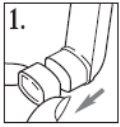
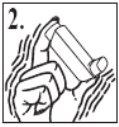
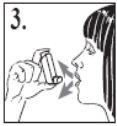
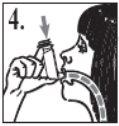
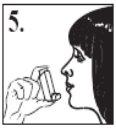
- It is recommended that you stand or sit upright while using the inhaler.
- Remove the mouthpiece cover (figure 1). Check inside and outside that the mouthpiece is clean and free from any foreign particles.
- Shake the inhaler 4 or 5 times to ensure that any foreign particles are removed and the contents of the inhaler are well mixed (figure 2).
- Hold the inhaler in a vertical position with your thumb on the base of the inhaler, below the mouthpiece. Expel as much air as possible (figure 3).
- Place the mouthpiece in your mouth, between your teeth. Close your lips around the mouthpiece. Do not bite it.
- Take a slow and deep breath in through your mouth. Immediately after starting to breathe in, press the top of the inhaler firmly to release the medication. Continue to breathe in slowly and deeply (figure 4).
- Hold your breath, remove the inhaler from your mouth by taking your finger off the top of the inhaler. Continue to hold your breath for a few seconds, as long as you can (figure 5).
- Wait for about half a minute between each application of the medication, then repeat steps 3 to 7.
- Afterward, rinse your mouth with water and spit it out and/or brush your teeth. This will help prevent the appearance of mouth ulcers and hoarseness.
- After use, always replace the mouthpiece cover immediately to protect it from dust. The mouthpiece cover will click into place. If it does not click, turn the mouthpiece cover, put it back on, and try again. Do not use excessive force.
Take your time in steps 4, 5, 6, and 7. It is essential that you start inhaling as slowly as possible just before using your inhaler. The first few times you use the inhaler, you should use it in front of a mirror. If you see "mist" coming out of the top of the inhaler or the sides of your mouth, you should start again from step 3.
If you find it difficult to use the inhaler, your doctor or another healthcare professional may recommend using the inhaler with a spacer, such as AeroChamber Plus®. Your doctor, nurse, pharmacist, or other healthcare professional should show you how to use the spacer with your inhaler, how to maintain your spacer, and answer any questions you may have. If you are using the spacer with your inhaler, it is essential that you do not stop using it without consulting your doctor or nurse first. Only the AeroChamber Plus®spacer should be used with Inantol.Other spacers should not be used with Inantol, and you should not switch from one spacer to another.If you stop using the spacer, your doctor may need to change the dose of medication needed to control your asthma. Always consult your doctor before making any changes to your asthma treatment.
People with little hand strength may find it easier to hold the inhaler with both hands. Place your two index fingers on the top of the inhaler and both thumbs on the base, below the mouthpiece.
You should get a replacement inhaler when the marker indicates 20 (figure 6). Stop using the inhaler when the marker indicates 0, as the applications left in the container may not be sufficient to complete a dose. Never try to modify the numbering on the marker or detach the marker from the plastic container.
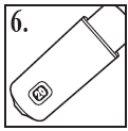
Cleaning the inhaler
To prevent the inhaler from becoming blocked, it is essential to clean it at least once a week.
To clean the inhaler:
- Remove the mouthpiece cover.
- Do not remove the canister from the plastic casing at any time.
- Clean the inside and outside of the mouthpiece and the plastic casing with a dry cloth.
- Replace the mouthpiece cover. It will click into place when it is correctly positioned. If it does not click, turn the mouthpiece cover, put it back on, and try again. Do not use excessive force.
Do not wash or put any part of the inhaler in water.
If you use more Inantol than you should
It is very important to use the inhaler exactly as directed. If you accidentally take a higher dose than recommended, consult your doctor or pharmacist. You may notice that your heart beats faster than normal and feel tremors. You may also experience dizziness, headache, muscle weakness, and joint pain.
If you have used large doses for extended periods, you should ask your doctor or pharmacist for advice. This is because high concentrations of this medication may reduce the amount of steroid hormones produced by the adrenal gland.
In case of overdose or accidental ingestion, consult your doctor or pharmacist immediately or call the Toxicology Information Service, phone: 91 562 04 20, indicating the medication and the amount ingested.
If you forget to use Inantol
Do not take a double dose to make up for forgotten doses. Take the next dose at the usual time.
If you stop using Inantol
It is very important that you use this medication every day as directed. Continue to take it until your doctor tells you to stop. Do not stop using this medication suddenly or reduce the dose.This could cause your breathing to worsen.
Additionally, if you stop taking this medication suddenly or reduce the dose, you may (very rarely) experience problems with your adrenal gland (adrenal insufficiency), which can sometimes cause side effects.
These side effects may include:
- Stomach pain.
- Fatigue and loss of appetite, feeling unwell.
- Nausea and diarrhea.
- Weight loss.
- Headache or drowsiness.
- Low blood sugar levels.
- Low blood pressure and seizures (fits).
When your body is under stress, such as fever, trauma (e.g., car accident), infection, or surgery, adrenal insufficiency may worsen, and you may experience any of the above side effects.
If you experience any side effects, consult your doctor or pharmacist. To prevent these symptoms, your doctor may prescribe an additional dose of corticosteroids in tablets during that time (such as prednisolone).
If you have any further questions about the use of this medication, ask your doctor, nurse, or pharmacist.
4. Possible Adverse Effects
Like all medicines, this medicine can cause adverse effects, although not all people suffer from them. To reduce the appearance of adverse effects, your doctor will prescribe the lowest dose of this medicine that controls your asthma.
Allergic Reactions: you may notice that your breathing suddenly worsens immediately after using Inantol. You may suffer from wheezing and coughing or shortness of breath. You may also notice itching, skin rash (urticaria), and swelling (usually in the face, lips, tongue, or throat). You may also suddenly feel that your heart is beating very fast, feel like you are losing consciousness, and feel dizzy (which can lead to collapse or loss of consciousness). If you experience any of these effects or if they appear suddenly after using this medicine, stop taking it and inform your doctor immediately.Allergic reactions to this medicine are rare (affect less than 1 in 100 people).
The following are other adverse effects:
Very Common (may affect more than 1 in 10 people)
- Headache, which usually improves as treatment continues.
- An increase in the number of colds has been reported in patients with COPD.
Common (may affect less than 1 in 10 people)
- Candidiasis (itching, appearance of yellowish-white ulcers) in the mouth and throat. Also, pain in the tongue, hoarse voice, and throat irritation. Rinsing the mouth with water and spitting it out and/or brushing your teeth immediately after each dose of medicine may help. For the treatment of candidiasis, your doctor may prescribe antifungal medication (for the treatment of fungal infections).
- Pain, inflammation in the joints, and muscle pain.
- Muscle cramps.
The following adverse effects have been reported in patients with Chronic Obstructive Pulmonary Disease (COPD):
- Pneumonia and bronchitis (lung infection). Inform your doctor if you notice any of the following symptoms: increased production of sputum, change in the color of sputum, fever, chills, increased coughing, increased difficulty breathing.
- Bruises and fractures.
- Inflammation of the sinuses (feeling of tension or congestion in the nose, cheeks, and behind the eyes, sometimes with a pulsating pain).
- Reduction of potassium levels in the blood (may feel irregular heartbeats, muscle weakness, cramps).
Uncommon (may affect less than 1 in 100 people)
- Increased blood sugar (glucose) levels (hyperglycemia). If you have diabetes, it will be necessary to monitor your blood sugar levels more frequently and adjust your usual diabetic treatment if necessary.
- Cataracts (opacity of the eye lens).
- Very fast heart rate (tachycardia).
- Feeling tremors and a fast or irregular heartbeat (palpitations). These adverse effects are usually harmless and decrease when treatment continues.
- Chest pain.
- Feeling of anxiety (occurs mainly in children).
- Sleep disorders.
- Skin rash.
- Allergic skin rash.
Rare (may affect less than 1 in 1,000 people)
- Breathing difficulties or wheezing that worsen immediately after using this medicine.If this happens, stop using this medicine. Use your rapid-acting "rescue" inhaler to improve your breathing and inform your doctor immediately.
- This medicine may increase the normal production of steroid hormones, particularly if you have been taking high doses for long periods. The effects include:
- Delayed growth in children and adolescents.
- Decreased bone mineral density.
- Glaucoma.
- Weight gain.
- Rounded face (moon face) (Cushing's syndrome).
- Your doctor will regularly monitor any of these adverse effects and ensure that you are taking the lowest dose of this medicine to control your asthma.
- Changes in behavior, such as hyperactivity and irritability (these effects occur mainly in children).
- Irregular heartbeats or extra heartbeats (arrhythmias). Consult your doctor, but do not stop taking this medicine unless your doctor tells you to do so.
- Fungal infection in the esophagus (throat), which can cause difficulty swallowing.
Frequency not known, but may also appear:
- Depression or aggression. These effects are more likely to occur in children.
- Blurred vision.
Reporting Adverse Effects
If you experience any type of adverse effect, consult your doctor or pharmacist, even if it is a possible adverse effect that is not listed in this prospectus. You can also report them directly through the Spanish Pharmacovigilance System for Human Use Medicines: https://www.notificaram.es. By reporting adverse effects, you can contribute to providing more information on the safety of this medicine.
5. Storage of Inantol
Keep this medicine out of the sight and reach of children.
Do not use this medicine after the expiration date that appears on the label and on the cardboard box after "CAD" or "EXP". The expiration date is the last day of the month indicated.
No special storage conditions are required.
The container contains a pressurized liquid. Do not expose to temperatures above 50°C, protect from direct sunlight. Do not puncture or burn the container, even if it is empty.
As with most inhalation medicines in pressurized containers, the therapeutic effect of this medicine may decrease if the container is cold.
Medicines should not be thrown away in drains or in the trash. Deposit the containers and medicines you no longer need in the SIGRE point of the pharmacy. In case of doubt, ask your pharmacist how to dispose of the containers and medicines you no longer need. This way, you will help protect the environment.
6. Container Contents and Additional Information
Inantol Composition
Each pressurized dose (released from the valve) contains 25 micrograms of salmeterol (as salmeterol xinafoate) and 125 or 250 micrograms of fluticasone propionate. This is equivalent to a released dose (released from the mouthpiece) of 21 micrograms of salmeterol and 110 or 220 micrograms of fluticasone propionate.
The other components are a propellant: norflurane (HFA 134a) and anhydrous ethanol.
Product Appearance and Container Contents
- Inantol inhaler is presented in a pressurized container with a counter, which releases the medicine in the form of a suspension for inhalation through the mouth to the lungs.
- The container contains a white to off-white inhalation suspension.
- The containers are inside a plastic applicator that incorporates a mouthpiece and a protector for it, colored mauve or purple.
- The applicator has a dose counter attached, which indicates the number of applications of the drug that remain. The number is visible through a window on the back of the applicator. A pressurized container releases 120 applications.
- The pressurized containers are presented in cardboard boxes that contain 1 inhaler. Each inhaler contains 120 fixed doses.
Marketing Authorization Holder:
Viatris Pharmaceuticals, S.L.U.
C/ General Aranaz, 86
28027 - Madrid
Spain
Manufacturer:
Mylan Germany GmbH
Benzstrasse 1
Bad Homburg,
Hesse,
61352,
Germany
or
McDermott Laboratories Limited t/a Gerard Laboratories,
35/36 Baldoyle Industrial Estate,
Grange Road,
Dublin 13,
Ireland
Date of the last revision of this prospectus:October 2023
Detailed information about this medicine is available on the website of the Spanish Agency for Medicines and Health Products (AEMPS) http://www.aemps.gob.es/
- Country of registration
- Active substance
- Prescription requiredYes
- Manufacturer
- CompositionETANOL ANHIDRO (0,7312 mg/pulsación mg)
- This information is for reference only and does not constitute medical advice. Always consult a licensed doctor before taking any medication. Oladoctor is not responsible for medical decisions based on this content.
- Alternatives to INANTOL 25/250 micrograms pressurized inhalation suspensionDosage form: PULMONARY INHALATION, 50 micrograms/250 microgramsActive substance: salmeterol and fluticasoneManufacturer: Sandoz Farmaceutica S.A.Prescription requiredDosage form: PULMONARY INHALATION, 50 micrograms/500 microgramsActive substance: salmeterol and fluticasoneManufacturer: Sandoz Farmaceutica S.A.Prescription requiredDosage form: PULMONARY INHALATION, 50 micrograms / 100 microgramsActive substance: salmeterol and fluticasoneManufacturer: Zentiva K.S.Prescription required




